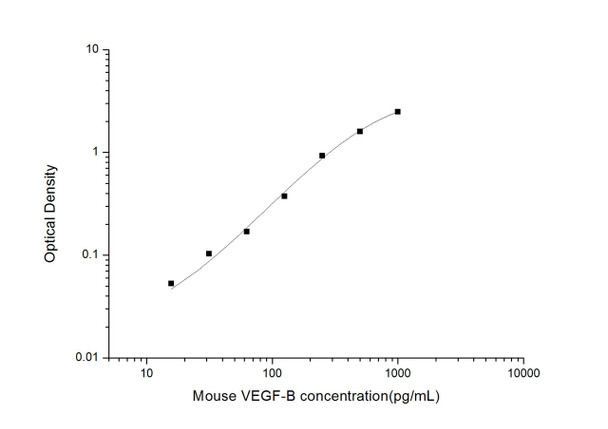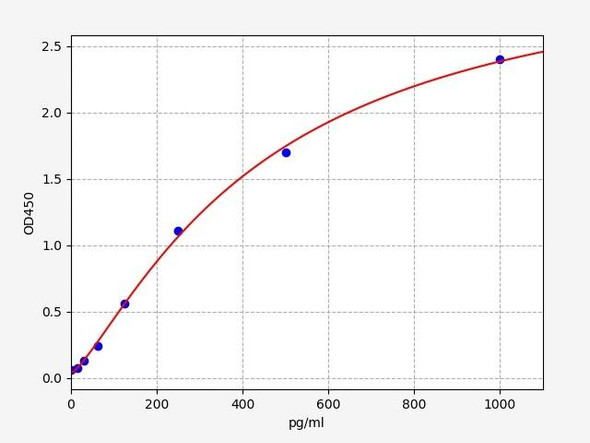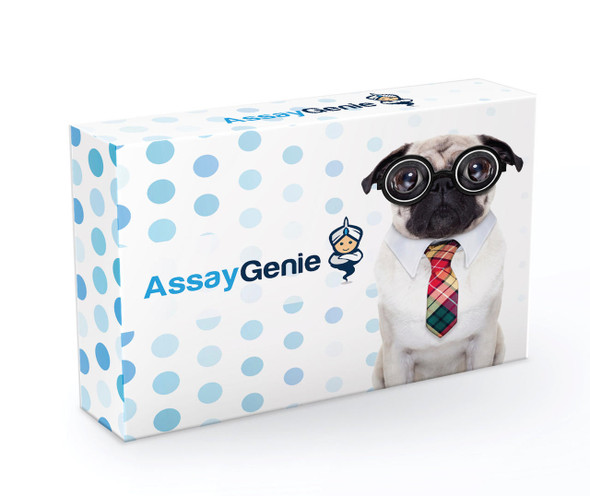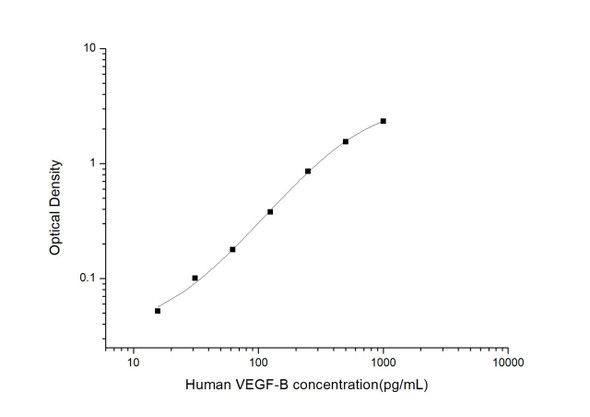Mouse Cardiovascular ELISA Kits
Mouse VEGF-B (Vascular Endothelial cell Growth Factor B) ELISA Kit (MOES01605)
- SKU:
- MOES01605
- Product Type:
- ELISA Kit
- Size:
- 96 Assays
- Uniprot:
- P49766
- Sensitivity:
- 9.38pg/mL
- Range:
- 15.63-1000pg/mL
- ELISA Type:
- Sandwich
- Synonyms:
- VEGFB, VEGFL, VRF
- Reactivity:
- Mouse
- Sample Type:
- Serum, plasma and other biological fluids
- Research Area:
- Cardiovascular
Description
| Assay type: | Sandwich |
| Format: | 96T |
| Assay time: | 4.5h |
| Reactivity: | Mouse |
| Detection Method: | Colormetric |
| Detection Range: | 15.63-1000 pg/mL |
| Sensitivity: | 9.38 pg/mL |
| Sample Volume Required Per Well: | 100µL |
| Sample Type: | Serum, plasma and other biological fluids |
| Specificity: | This kit recognizes Mouse VEGF-B in samples. No significant cross-reactivity or interference between Mouse VEGF-B and analogues was observed. |
This ELISA kit uses Sandwich-ELISA as the method. The micro ELISA plate provided in this kit has been pre-coated with an antibody specific to Mouse VEGF-B. Standards or samples are added to the appropriate micro ELISA plate wells and combined with the specific antibody. Then a biotinylated detection antibody specific for Mouse VEGF-B and Avidin-Horseradish Peroxidase (HRP) conjugate are added to each micro plate well successively and incubated. Free components are washed away. The substrate solution is added to each well. Only those wells that contain Mouse VEGF-B, biotinylated detection antibody and Avidin-HRP conjugate will appear blue in color. The enzyme-substrate reaction is terminated by adding Stop Solution and the color turns yellow. The optical density (OD) is measured spectrophotometrically at a wavelength of 450 nm ± 2 nm. The OD value is proportional to the concentration of Mouse VEGF-B. The concentration of Mouse VEGF-B in samples can be calculated by comparing the OD of the samples to the standard curve.
| UniProt Protein Function: | VEGF: Growth factor active in angiogenesis, vasculogenesis and endothelial cell growth. Induces endothelial cell proliferation, promotes cell migration, inhibits apoptosis and induces permeabilization of blood vessels. Binds to the FLT1/VEGFR1 and KDR/VEGFR2 receptors, heparan sulfate and heparin. NRP1/Neuropilin-1 binds isoforms VEGF-165 and VEGF-145. Isoform VEGF165B binds to KDR but does not activate downstream signaling pathways, does not activate angiogenesis and inhibits tumor growth. Defects in VEGFA are a cause of susceptibility to microvascular complications of diabetes type 1 (MVCD1). These are pathological conditions that develop in numerous tissues and organs as a consequence of diabetes mellitus. They include diabetic retinopathy, diabetic nephropathy leading to end-stage renal disease, and diabetic neuropathy. Diabetic retinopathy remains the major cause of new-onset blindness among diabetic adults. It is characterized by vascular permeability and increased tissue ischemia and angiogenesis. Belongs to the PDGF/VEGF growth factor family. 13 isoforms of the human protein are produced by alternative promoter. |
| UniProt Protein Details: | Protein type:Motility/polarity/chemotaxis; Cytokine; Secreted; Secreted, signal peptide Cellular Component: extracellular space; cell surface; membrane; cytoplasm; plasma membrane; extracellular region; basement membrane; secretory granule Molecular Function:heparin binding; identical protein binding; protein homodimerization activity; growth factor activity; extracellular matrix binding; cytokine activity; platelet-derived growth factor receptor binding; vascular endothelial growth factor receptor 1 binding; vascular endothelial growth factor receptor binding; receptor agonist activity; protein binding; vascular endothelial growth factor receptor 2 binding; protein heterodimerization activity; fibronectin binding; receptor binding; chemoattractant activity Biological Process: heart morphogenesis; positive regulation of cell adhesion; macrophage differentiation; positive regulation of positive chemotaxis; multicellular organismal development; cell maturation; positive regulation of receptor internalization; basophil chemotaxis; regulation of cell shape; positive regulation of MAP kinase activity; positive chemotaxis; positive regulation of mesenchymal cell proliferation; mesoderm development; negative regulation of neuron apoptosis; kidney development; positive regulation of neuroblast proliferation; nervous system development; T-helper 1 type immune response; positive regulation of signal transduction; monocyte differentiation; mRNA stabilization; positive regulation of blood vessel endothelial cell migration; activation of CREB transcription factor; positive regulation of protein amino acid autophosphorylation; positive regulation of vascular permeability; regulation of endothelial cell differentiation; patterning of blood vessels; regulation of transcription from RNA polymerase II promoter; eye photoreceptor cell development; positive regulation of angiogenesis; positive regulation of peptidyl-tyrosine phosphorylation; camera-type eye morphogenesis; branching morphogenesis of a tube; cell migration during sprouting angiogenesis; cardiac muscle fiber development; positive regulation of cell division; positive regulation of axon extension involved in axon guidance; activation of protein kinase activity; blood vessel morphogenesis; endothelial cell migration; neuron development; positive regulation of transcription from RNA polymerase II promoter; positive regulation of endothelial cell proliferation; regulation of cGMP metabolic process; surfactant homeostasis; alveolus development; positive regulation of epithelial cell proliferation; negative regulation of apoptosis; lactation; post-embryonic camera-type eye development; positive regulation of smooth muscle cell proliferation; negative regulation of caspase activity; negative regulation of transcription from RNA polymerase II promoter; positive regulation of vascular endothelial growth factor receptor signaling pathway; induction of positive chemotaxis; positive regulation of focal adhesion formation; epithelial cell differentiation; ovarian follicle development; vasculature development; lymphangiogenesis; positive regulation of cell proliferation; negative regulation of programmed cell death; angiogenesis; cell differentiation; negative regulation of bone resorption; blood vessel development; cell migration; in utero embryonic development; lumen formation; positive regulation of cell motility; positive regulation of peptidyl-serine phosphorylation; positive regulation of protein kinase B signaling cascade; cell proliferation; positive regulation of protein complex assembly; response to hypoxia; artery morphogenesis; blood vessel remodeling; negative regulation of cell-cell adhesion; positive regulation of protein amino acid phosphorylation; sprouting angiogenesis; vascular endothelial growth factor receptor signaling pathway; lung development; growth; positive regulation of cell migration |
| NCBI Summary: | This gene is a member of the PDGF/VEGF growth factor family. It encodes a heparin-binding protein, which exists as a disulfide-linked homodimer. This growth factor induces proliferation and migration of vascular endothelial cells, and is essential for both physiological and pathological angiogenesis. Disruption of this gene in mice resulted in abnormal embryonic blood vessel formation. This gene is upregulated in many known tumors and its expression is correlated with tumor stage and progression. Alternatively spliced transcript variants encoding different isoforms have been found for this gene. There is also evidence for alternative translation initiation from upstream non-AUG (CUG) codons resulting in additional isoforms. A recent study showed that a C-terminally extended isoform is produced by use of an alternative in-frame translation termination codon via a stop codon readthrough mechanism, and that this isoform is antiangiogenic. Expression of some isoforms derived from the AUG start codon is regulated by a small upstream open reading frame, which is located within an internal ribosome entry site. [provided by RefSeq, Nov 2015] |
| UniProt Code: | P49766 |
| NCBI GenInfo Identifier: | 160358799 |
| NCBI Gene ID: | 22339 |
| NCBI Accession: | NP_001020421. 2 |
| UniProt Secondary Accession: | P49766,P49766, |
| UniProt Related Accession: | Q00731 |
| Molecular Weight: | |
| NCBI Full Name: | vascular endothelial growth factor A isoform 1 |
| NCBI Synonym Full Names: | vascular endothelial growth factor A |
| NCBI Official Symbol: | Vegfa |
| NCBI Official Synonym Symbols: | Vpf; Vegf |
| NCBI Protein Information: | vascular endothelial growth factor A |
| UniProt Protein Name: | Vascular endothelial growth factor A |
| UniProt Synonym Protein Names: | Vascular permeability factor; VPF |
| Protein Family: | VEGF coregulated chemokine |
| UniProt Gene Name: | Vegfa |
| UniProt Entry Name: | VEGFA_MOUSE |
As the OD values of the standard curve may vary according to the conditions of the actual assay performance (e. g. operator, pipetting technique, washing technique or temperature effects), the operator should establish a standard curve for each test. Typical standard curve and data is provided below for reference only.
| Concentration (pg/mL) | O.D | Average | Corrected |
| 1000 | 2.532 2.586 | 2.559 | 2.491 |
| 500 | 1.668 1.676 | 1.672 | 1.604 |
| 250 | 1.014 0.98 | 0.997 | 0.929 |
| 125 | 0.44 0.446 | 0.443 | 0.375 |
| 62.5 | 0.238 0.238 | 0.238 | 0.17 |
| 31.25 | 0.177 0.165 | 0.171 | 0.103 |
| 15.63 | 0.116 0.126 | 0.121 | 0.053 |
| 0 | 0.058 0.078 | 0.068 | -- |
Precision
Intra-assay Precision (Precision within an assay): 3 samples with low, mid range and high level Mouse VEGF-B were tested 20 times on one plate, respectively.
Inter-assay Precision (Precision between assays): 3 samples with low, mid range and high level Mouse VEGF-B were tested on 3 different plates, 20 replicates in each plate.
| Intra-assay Precision | Inter-assay Precision | |||||
| Sample | 1 | 2 | 3 | 1 | 2 | 3 |
| n | 20 | 20 | 20 | 20 | 20 | 20 |
| Mean (pg/mL) | 45.70 | 97.60 | 357.20 | 49.70 | 89.50 | 359.10 |
| Standard deviation | 2.80 | 4.10 | 15.00 | 2.60 | 5.10 | 15.10 |
| C V (%) | 6.13 | 4.20 | 4.20 | 5.23 | 5.70 | 4.20 |
Recovery
The recovery of Mouse VEGF-B spiked at three different levels in samples throughout the range of the assay was evaluated in various matrices.
| Sample Type | Range (%) | Average Recovery (%) |
| Serum (n=5) | 95-107 | 100 |
| EDTA plasma (n=5) | 89-100 | 95 |
| Cell culture media (n=5) | 95-111 | 101 |
Linearity
Samples were spiked with high concentrations of Mouse VEGF-B and diluted with Reference Standard & Sample Diluent to produce samples with values within the range of the assay.
| Serum (n=5) | EDTA plasma (n=5) | Cell culture media (n=5) | ||
| 1:2 | Range (%) | 89-100 | 96-109 | 95-108 |
| Average (%) | 95 | 102 | 102 | |
| 1:4 | Range (%) | 99-112 | 86-99 | 91-103 |
| Average (%) | 106 | 91 | 98 | |
| 1:8 | Range (%) | 99-115 | 85-98 | 93-105 |
| Average (%) | 106 | 92 | 100 | |
| 1:16 | Range (%) | 100-114 | 87-100 | 98-112 |
| Average (%) | 107 | 92 | 105 |
An unopened kit can be stored at 4°C for 1 month. If the kit is not used within 1 month, store the items separately according to the following conditions once the kit is received.
| Item | Specifications | Storage |
| Micro ELISA Plate(Dismountable) | 8 wells ×12 strips | -20°C, 6 months |
| Reference Standard | 2 vials | |
| Concentrated Biotinylated Detection Ab (100×) | 1 vial, 120 µL | |
| Concentrated HRP Conjugate (100×) | 1 vial, 120 µL | -20°C(shading light), 6 months |
| Reference Standard & Sample Diluent | 1 vial, 20 mL | 4°C, 6 months |
| Biotinylated Detection Ab Diluent | 1 vial, 14 mL | |
| HRP Conjugate Diluent | 1 vial, 14 mL | |
| Concentrated Wash Buffer (25×) | 1 vial, 30 mL | |
| Substrate Reagent | 1 vial, 10 mL | 4°C(shading light) |
| Stop Solution | 1 vial, 10 mL | 4°C |
| Plate Sealer | 5 pieces | |
| Product Description | 1 copy | |
| Certificate of Analysis | 1 copy |
- Set standard, test sample and control (zero) wells on the pre-coated plate and record theirpositions. It is recommended to measure each standard and sample in duplicate. Note: addall solutions to the bottom of the plate wells while avoiding contact with the well walls. Ensuresolutions do not foam when adding to the wells.
- Aliquot 100µl of standard solutions into the standard wells.
- Add 100µl of Sample / Standard dilution buffer into the control (zero) well.
- Add 100µl of properly diluted sample (serum, plasma, tissue homogenates and otherbiological fluids) into test sample wells.
- Cover the plate with the sealer provided in the kit and incubate for 90 min at 37°C.
- Aspirate the liquid from each well, do not wash. Immediately add 100µL of BiotinylatedDetection Ab working solution to each well. Cover the plate with a plate seal and gently mix. Incubate for 1 hour at 37°C.
- Aspirate or decant the solution from the plate and add 350µL of wash buffer to each welland incubate for 1-2 minutes at room temperature. Aspirate the solution from each well andclap the plate on absorbent filter paper to dry. Repeat this process 3 times. Note: a microplatewasher can be used in this step and other wash steps.
- Add 100µL of HRP Conjugate working solution to each well. Cover with a plate seal andincubate for 30 min at 37°C.
- Aspirate or decant the solution from each well. Repeat the wash process for five times asconducted in step 7.
- Add 90µL of Substrate Reagent to each well. Cover with a new plate seal and incubate forapproximately 15 min at 37°C. Protect the plate from light. Note: the reaction time can beshortened or extended according to the actual color change, but not by more than 30min.
- Add 50 µL of Stop Solution to each well. Note: Adding the stop solution should be done inthe same order as the substrate solution.
- Determine the optical density (OD value) of each well immediately with a microplate readerset at 450 nm.






